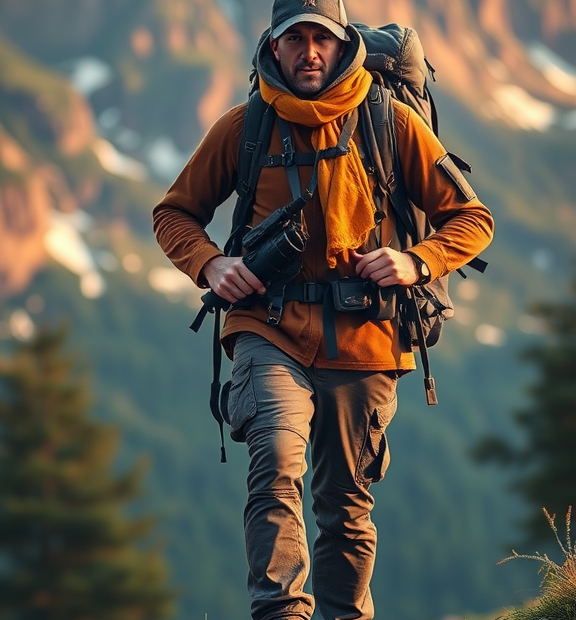Essential Travel Outfit Components for Trekking
Preparing the right travel outfit for trekking can make the difference between an exhilarating adventure and a miserable experience. Seasoned hikers understand that clothing is more than just fashion—it’s a critical tool for comfort, protection, and performance in challenging outdoor environments.
Layering: The Foundation of Smart Trekking Apparel
Successful trekking outfits rely on a strategic layering system that adapts to changing weather conditions and physical exertion. Start with a moisture-wicking base layer that pulls sweat away from your skin, preventing chills and potential hypothermia. Opt for lightweight, quick-drying materials like merino wool or synthetic performance fabrics.
Insulation Strategies
Your mid-layer should provide warmth without adding excessive bulk. Consider lightweight fleece jackets or thin down jackets that compress easily in your backpack. These pieces trap heat while remaining breathable, ensuring you stay comfortable during varying intensity levels of hiking.
Outer Layer Protection
The outer layer serves as your shield against wind, rain, and environmental elements. Invest in a high-quality waterproof and breathable shell jacket that offers maximum protection without compromising mobility. Look for jackets with ventilation zippers and sealed seams for comprehensive weather resistance.
Selecting the Perfect Trekking Pants
Trekking pants should balance durability, flexibility, and comfort. Choose pants made from lightweight, stretchy materials that allow unrestricted movement. Convertible pants with zip-off legs provide versatility, transforming from full-length to shorts as temperatures change.
- Prefer pants with reinforced knees and seat areas
- Select quick-drying fabrics
- Consider built-in UV protection
- Ensure multiple secure pockets for essential items
Footwear Considerations
Your feet are your most critical asset during trekking. Invest in high-quality hiking boots or trail shoes that match your terrain and personal comfort needs. Waterproof materials with excellent ankle support can prevent injuries and keep your feet dry.
Sock Selection Matters
Never underestimate the importance of proper hiking socks. Merino wool blends offer moisture-wicking properties, temperature regulation, and blister prevention. Pack multiple pairs to ensure dry, comfortable feet throughout your journey.
Accessories for Enhanced Comfort
Love what I do? Be a hero and help me keep creating awesome content!
Support My Mission Now!Every donation fuels more great stuff – thank you, legend!
Strategic accessories can elevate your trekking outfit’s functionality. A lightweight, moisture-wicking buff can serve multiple purposes—protecting your neck from sun, acting as a headband, or providing additional warmth when needed.
Sun and Weather Protection
Include a wide-brimmed hat or cap with neck protection to shield against intense sunlight. Lightweight, breathable gloves can protect your hands during cooler temperatures or while navigating rocky terrain.
Material Technology Considerations
Love what I do? Be a hero and help me keep creating awesome content!
Support My Mission Now!Every donation fuels more great stuff – thank you, legend!
Modern trekking apparel incorporates advanced fabric technologies. Seek out clothing with antimicrobial treatments that reduce odor, UPF protection against harmful sun rays, and mechanical stretch for enhanced mobility.
Pack Smart, Travel Light
Choose versatile pieces that can be mixed and matched. Neutral colors like gray, tan, and navy provide practical advantages, hiding dirt and allowing easier coordination between garments.
Remember that the perfect trekking outfit is a personal choice influenced by your specific adventure, physical condition, and environmental conditions. Prioritize comfort, functionality, and adaptability when making your selections.
Layering Strategies for Extreme Terrain Conditions
Love what I do? Be a hero and help me keep creating awesome content!
Support My Mission Now!Every donation fuels more great stuff – thank you, legend!
When conquering challenging terrains and extreme landscapes, your clothing becomes more than just a fashion statement—it’s your primary defense against harsh environmental conditions. Experienced trekkers understand that strategic layering isn’t just about staying warm; it’s about maintaining optimal body temperature, managing moisture, and protecting yourself from unpredictable weather changes.
Understanding Thermal Regulation Principles
Professional adventurers know that effective layering starts with understanding how different fabrics interact with your body’s natural temperature management. The key is creating a versatile system that allows quick adjustments based on altitude, physical exertion, and environmental shifts.
Base Layer Fundamentals
Love what I do? Be a hero and help me keep creating awesome content!
Support My Mission Now!Every donation fuels more great stuff – thank you, legend!
Your base layer acts as a critical moisture-wicking foundation. Opt for lightweight, quick-drying materials like merino wool or synthetic performance fabrics that draw sweat away from your skin. These materials prevent moisture buildup, which can cause rapid heat loss and potential hypothermia in challenging conditions.
Insulation Layer Strategies
The middle layer serves as your primary insulation component. Lightweight fleece or down jackets provide exceptional warmth without adding significant bulk. Modern synthetic insulators offer remarkable heat retention even when slightly damp, making them superior to traditional cotton materials.
Advanced Material Selection
- Merino wool: Natural temperature regulation
- Synthetic polyester: Quick-drying capabilities
- Treated down: Water-resistant insulation
- Primaloft: Maintains warmth when wet
Outer Shell Protection
Your exterior layer must withstand extreme conditions while allowing breathability. Waterproof and windproof jackets with ventilation zippers provide maximum protection against harsh elements. Look for materials with Gore-Tex or similar advanced membrane technologies that block external moisture while permitting internal vapor escape.
Terrain-Specific Considerations
Different landscapes demand specialized approaches. Alpine environments require more robust layering compared to desert trekking. High-altitude expeditions necessitate multiple thin layers that can be easily added or removed, whereas tropical terrains demand lightweight, breathable configurations.
Weight and Packability
Modern trekking enthusiasts prioritize gear that offers maximum performance with minimal weight. Compact, compressible layers that can be efficiently packed represent the pinnacle of travel clothing technology. Innovations in fabric engineering now produce incredibly lightweight materials that provide exceptional thermal protection.
Movement and Flexibility Factors
Technical trekking clothing must accommodate dynamic movement without restricting mobility. Articulated joints, stretch panels, and ergonomic design ensure that your clothing moves with your body, preventing chafing and maintaining comfort during extended journeys.
Moisture Management Techniques
Sophisticated moisture management goes beyond basic sweat absorption. Advanced fabrics now incorporate antimicrobial treatments that reduce odor and bacterial growth. This becomes crucial during multi-day expeditions where changing clothes isn’t always feasible.
Additional Protection Elements
- UV-protective fabrics
- Reinforced wear points
- Quick-drying properties
- Integrated ventilation systems
Investing in high-quality, strategically designed trekking apparel transforms your outdoor experience. By understanding layering principles and selecting appropriate materials, you create a personal microclimate that adapts to changing environmental demands, ensuring comfort, safety, and performance across diverse terrains.
Conclusion
Selecting the perfect travel outfit for trekking is more than just a fashion statement—it’s a critical decision that can significantly impact your comfort, performance, and overall outdoor experience. By carefully choosing versatile, functional clothing and implementing strategic layering techniques, adventurers can confidently navigate diverse and challenging terrains.
Love what I do? Be a hero and help me keep creating awesome content!
Support My Mission Now!Every donation fuels more great stuff – thank you, legend!
The key to an exceptional trekking wardrobe lies in understanding the intricate balance between protection, flexibility, and adaptability. High-performance fabrics that wick moisture, provide thermal regulation, and offer durability are essential investments for serious travelers. Whether you’re crossing alpine landscapes or exploring dense forest trails, your clothing becomes your primary defense against environmental variables.
Layering remains the ultimate strategy for managing body temperature and protecting yourself from unpredictable weather conditions. By thoughtfully combining base layers, insulating mid-layers, and protective outer shells, trekkers can seamlessly adjust to shifting climates without compromising mobility or comfort. This approach allows for quick adaptations, ensuring you remain comfortable and prepared throughout your journey.
Love what I do? Be a hero and help me keep creating awesome content!
Support My Mission Now!Every donation fuels more great stuff – thank you, legend!
Ultimately, your travel outfit is a personal toolkit designed to enhance your trekking performance. Prioritize quality, functionality, and versatility over trendy designs. Remember that the right clothing can transform challenging outdoor experiences into memorable adventures, providing the confidence and protection needed to explore the world’s most remarkable landscapes.
Smart trekkers recognize that their outfit is not just clothing—it’s specialized gear engineered to support their most ambitious wilderness pursuits. Invest wisely, plan meticulously, and embrace the transformative power of thoughtfully selected travel attire.

